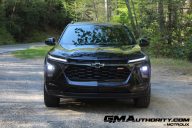With high gas prices and other inflated cost of living expenses, the number of miles you can get out of a tank remains a major concern for the majority of consumers. As such, it’s likely many readers out there are keeping a keen eye on the estimated driving range presented in their vehicle’s gauge cluster. However, some folks have reached out to GM Authority saying that this number can fluctuate after a fill-up. So what exactly is going on, and how can you keep those numbers as high as possible?
Essentially, the number displayed in your vehicle driving range indicator is based on a calculation that takes into account your fuel consumption rate and the amount of fuel that’s left in the tank. The higher the consumption rate, the lower the estimated driving range, and vice versa.
Of course, fuel consumption rate is based on a variety of different factors. A good number of these are typically out of the control of the individual behind the wheel, such as the slope or grade of the road, with a higher angle or grade (or steeper climb) resulting in a decrease in fuel economy, and a lower angle or grade (as well as a downward slope) resulting in an increase. Other ambient factors out of the control of the driver include air temperature, with particularly cold or hot weather affecting the efficiency of the internal combustion engine through things like air density (air is less dense in hotter weather) and the time it takes an engine to reach optimal operating temperatures (colder weather results in a longer warm-up period).
That all said, there are several things that the driver can do to improve their overall fuel efficiency. A more efficient engine is the first obvious factor, but there are also factors like tire pressure, with an under-inflated tire typically exhibiting greater rolling resistance, thus decreasing fuel economy. The use of ancillary equipment such as the air conditioner, heater, lighting, or stereo can also play a major role in how much fuel is consumed, as does vehicle maintenance (oil changes, air filters, etc.) and vehicle weight (less stuff in the cabin, more miles on the road).
That all said, one of the biggest factors in maximizing driving range remains driving style, with a smooth, steady application of the throttle and and less stop-and-go paying huge dividends at the pump. So ease up on the long skinny pedal, and you’ll be driving past that local gas station in no time.

















Comments
These things are suggestions not scientific measurements. This is why so many web claims of ultra high mpg are off.
You don’t drive or buy a corvette to ease up on the skinny pedal.
Yep, its more about SPG, smiles per gallon.
You don’t buy a Corvette to see how slow you can go!
Anyone too stupid to know this should not even be granted a driver’s license much less own a car!
Life 101:
1. Never borrow what a bank says you can afford.
2. Never trust a gas gauge.
As for #2, the gauge on any given vehicle will maybe be accurate to 1/8 tank if you’re lucky. The “miles remaining” on the dash? Forget it. Keep at least a 1/4 tank, and don’t risk something so avoidable.
Another unneeded option to quit working.
That red CT5 will not pump gas by itself.
Funny I thought this article was about mileage calculation after a fill up. As in in Canada, why does my Cadillac Escalade say 565 or 485 or I got even 905km on a fill on the screen before driving. So why the variation at the fill up between each fill. I’m not talking driving mileage, I’m talking filling up the dam tank. I started going really slow with the fill up and I get a higher number of km I can go.
I too thought that this article was going to tell me why the range calculation on my full-sized GM SUV is so inconsistent and volatile in showing remaining range. I thought that I would learn about the algorithm and why it is so flawed. Instead I read a bunch of common sense about how to get better fuel economy. Idiotic article.